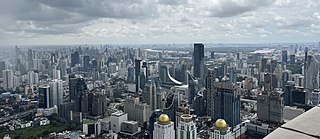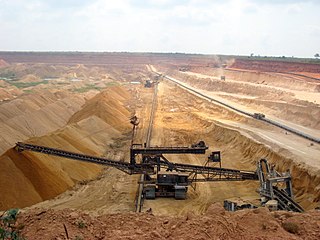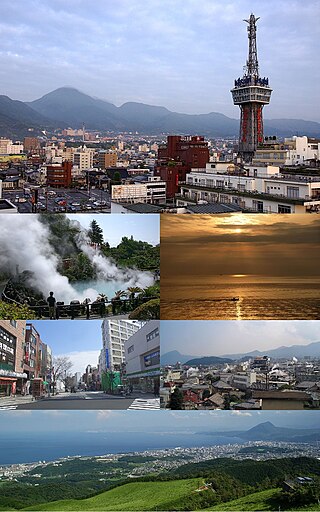Related Research Articles

Kyūshū is the third-largest island of Japan's four main islands and the most southerly of the four largest islands. In the past, it has been known as Kyūkoku, Chinzei and Tsukushi-no-shima. The historical regional name Saikaidō referred to Kyushu and its surrounding islands. Kyushu has a land area of 36,782 square kilometres (14,202 sq mi) and a population of 14,311,224 in 2018.

The economy of Laos is a lower-middle income developing economy. Being a socialist state, the Lao economic model resembles the Chinese socialist market and/or Vietnamese socialist-oriented market economies by combining high degrees of state ownership with openness to foreign direct investment and private ownership in a predominantly market-based framework.

The economy of Thailand is dependent on exports, which accounted in 2021 for about 58 per cent of the country's gross domestic product (GDP). Thailand itself is a newly industrialized country, with a GDP of 17.367 trillion baht (US$495 billion) in 2022, the 9th largest economy in Asia. As of 2018, Thailand has an average inflation of 1.06% and an account surplus of 7.5% of the country's GDP. Its currency, the Thai Baht, ranked as the tenth most frequently used world payment currency in 2017.

The economy of Togo has struggled greatly. The International Monetary Fund (IMF) ranks it as the tenth poorest country in the world, with development undercut by political instability, lowered commodity prices, and external debts. While industry and services play a role, the economy is dependent on subsistence agriculture, with industrialization and regional banking suffering major setbacks.

The economy of Guyana is one of the fastest growing economies in the world with a gross domestic product (GDP) growth of 19.9% in 2021. In 2024, Guyana had a per capita gross domestic product of Int$80,137 and an average GDP growth of 4.2% over the previous decade. Guyana's economy was transformed in 2015 with the discovery of an offshore oil field in the country's waters about 190 km from Georgetown, making the first commercial-grade crude oil draw in December 2019, sending it abroad for refining.

Tourism in Japan is a major industry and contributor to the Japanese economy. Foreigners visit Japan to see natural wonders, cities, historic landmarks, and entertainment venues. Japanese people seek similar attractions, as well as recreation and vacation areas. In 2019, Japan attracted 31.88 million international tourists. Japan welcomed 2.78 million visitor arrivals in February 2024, surpassing 2019 levels.

In general, a rural area or a countryside is a geographic area that is located outside towns and cities. Typical rural areas have a low population density and small settlements. Agricultural areas and areas with forestry are typically described as rural, as well as other areas lacking substantial development. Different countries have varying definitions of rural for statistical and administrative purposes.

Ōita Prefecture is a prefecture of Japan located on the island of Kyūshū. Ōita Prefecture has a population of 1,136,245 and has a geographic area of 6,340 km2. Ōita Prefecture borders Fukuoka Prefecture to the northwest, Kumamoto Prefecture to the southwest, and Miyazaki Prefecture to the south.

Usa is a city located in Ōita Prefecture, Japan. As of 30 November 2023, the city had an estimated population of 52,808 in 26026 households, and a population density of 120 persons per km2. The total area of the city is 439.05 km2 (169.52 sq mi). It is notable for Usa Jingū, the head shrine of all 40,000 Hachiman shrines across Japan.

Beppu is a city in Ōita Prefecture on the island of Kyushu, Japan. As of November 30, 2023, the city had a population of 113,045 in 62702 households, and a population density of 900 persons per km2. The total area of the city is 125.34 km2 (48.39 sq mi). Beppu is famous for its hot springs.
Education in Thailand is provided mainly by the Thai government through the Ministry of Education from pre-school to senior high school. A free basic education to fifteen years is guaranteed by the Thai constitution. This basic education comprises six years of elementary school and three years of lower secondary school. In addition, three years of pre-school and three years of upper-secondary education is available free of charge, but are non-compulsory.
Environmental pollution in Japan has accompanied industrialization since the Meiji period. One of the earliest cases was the copper poisoning caused by drainage from the Ashio Copper Mine in Tochigi Prefecture, beginning as early as 1878. Repeated floods occurred in the Watarase River basin, and 1,600 hectares of farmland and towns and villages in Tochigi and Gunma prefectures were damaged by the floodwater, which contained excessive inorganic copper compounds from the Ashio mine. The local breeders led by Shōzō Tanaka, a member of the Lower House from Tochigi appealed to the prefecture and the government to call a halt to the mining operations. Although the mining company paid compensatory money and the government engaged in the embankment works of the Watarase River, no fundamental solution of the problem was achieved.

Bungo-Ōno is a city located in Ōita Prefecture, Japan. As of 30 November 2023, the city had an estimated population of 32,846 in 15706 households, and a population density of 54 persons per km2. The total area of the city is 603.13 km2 (232.87 sq mi).

Ōita is the capital city of Ōita Prefecture, located on the island of Kyushu, Japan. As of 30 November 2023, the city had an estimated population of 474,804 in 230,867 households, and a population density of 950 persons per km2. The total area of the city is 502.38 km2 (193.97 sq mi).

Kabosu is a citrus fruit of an evergreen broad-leaf tree in the family Rutaceae. It is popular in Japan, where its juice is used to improve the taste of many dishes, especially cooked fish, sashimi, and hot pot dishes.
One Tambon One Product (OTOP) is a local entrepreneurship stimulus program designed by Thailand's former Prime Minister Thaksin Shinawatra during his 2001-2006 Thai Rak Thai government. The program aimed to support locally made and marketed products of each of Thailand's 7,255 tambons (sub-district). Drawing its inspiration from Japan's successful One Village One Product (OVOP) program, the OTOP program encourages village communities to improve the quality and marketing of local products, selecting one superior product from each tambon to receive formal branding as its "starred OTOP product". It provides both a local and national stage to the promote these products. OTOP includes a large array of local products, including traditional handicrafts, cotton and silk garments, pottery, fashion accessories, household items, and foods. After a military junta overthrew Thaksin's government in 2006 following an election cancelled for irregularities, the OTOP program was cancelled. However, it was soon revived and rebranded.

Oita Broadcasting System, Inc. or OBS is a television company based in Ōita Prefecture, Japan.
Morihiko Hiramatsu was a Japanese politician who was governor of Ōita Prefecture from April 1979 to April 2003. He is best known for initiating the One Village One Product movement in the prefecture, which was later followed by various other countries.

Agriculture in Ghana consists of a variety of agricultural products and is an established economic sector, providing employment on a formal and informal basis. It is represented by the Ministry of Food and Agriculture. Ghana produces a variety of crops in various climatic zones which range from dry savanna to wet forest which run in east–west bands across Ghana. Agricultural crops, including yams, grains, cocoa, oil palms, kola nuts, and timber, form the base of agriculture in Ghana's economy. In 2013 agriculture employed 53.6% of the total labor force in Ghana.
References
- 1 2 "Global application of the One Village One Product Movement concept: Lessons from the experiences of the Japan International Cooperation Agency". FAO Knowledge Repository. 2022. Retrieved 3 October 2024.
- ↑ Haraguchi, Nobuya (2008). "The One-Village-One-Product (OVOP) movement: What it is, how it has been replicated, and recommendations for a UNIDO OVOP-type project" (PDF). UNIDO. p. 6. Retrieved 3 October 2024.
- ↑ "Improvement Rural Living Condition through One Village One Product (OVOP) Movement" (PDF). ASEAN.org. 2014. Retrieved 3 October 2024.
- ↑ Ueda, Takafumi. "One Village One Product (OVOP) Movement". openknowledge.fao.org. p. 31. Retrieved 3 October 2024.
- ↑ "การแปลงแผนพัฒนาเศรษฐกิจและสังคม แห่งชาติ ฉบับที่ 8 ไปสู่การปฏิบัติ" (PDF). Legislative Institutional Repository of Thailand (in Thai). Retrieved 3 October 2024.